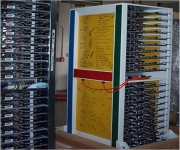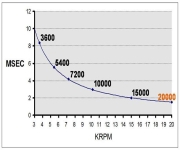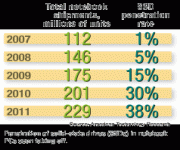Archive For The “Hardware” Category
IBM just announced achieving over one million Input-output operations per second: IBM Breaks Performance Records Through Systems Innovation. That’s an impressive number. To put the achievement in context, a very good (and way too expensive) enterprise disk will deliver somewhere between 180 to just over 200 IOPS. A respectable, but commodity, SATA disk will usually…
Recently results from two academic researchers in Japan will be significant to the NAND Flash market: http://www.electronicsweekly.com/Articles/Article.aspx?liArticleID=44028&PrinterFriendly=true. Clearly the trip from laboratory to volume production is often longer than the early estimates but these results look important. Back in 2006, Jim Gray argued in Tape is Dead, Disk is Tape, Flash is Disk, & Ram…
Updated below with additional implementation details. Last week Spansion made an interesting announcement: EcoRAM, a NOR Flash based storage part in a Dual In-line Memory Module (DIMM) package. NOR Flash technology growth has been fueled by the NOR support for Execute in Place (XIP). Unlike the NAND Flash interface, where entire memory pages need to…

Jeff Dean did a great talk at Google IO this year. Some key points from Steve Garrity (msft pm) and some note from the excellent write-up at Google spotlights data center inner workings: · many unreliable servers to fewer high cost servers · Single search query touches 700 to up to 1k machines in <…
There was an interesting talk earlier today at Microsoft Research by Jason Cong of the UCLA Computer Science Department on compiling design specifications in C/C++/SystemC and user constraints into ASIC and FPGA design. The advantage of compiler based approaches include, more productivity working at a higher level, automating verification, allows optimization, and allows rapid experimentation…
The years of Moore’s law growth without regard to power consumption are now over. On the data center side, power isn’t close to the largest cost of running a large service but it is one of the largest controllable costs and it has been in the press frequently of late. On the client side, battery…
Flash SSDs in laptops have generated considerable excitement over the last year and are in use at both extremes of the laptop market. At the very low end, where only very small storage amounts can be funded, NAND Flash is below the below the disk price floor. Mechanical disks with all their complexity are very…
The only thing worse than no backups is restoring bad backups. A database guy should get these things right. But, I didn’t, and earlier today I made some major site-wide changes and, as a side effect, this blog was restored to December 4th, 2007. I’m working on recovering the content and will come up with…
Past experience suggests that disk and memory are the most common server component failures but what about power supplies and mother boards? Amaya Souarez of Global Foundation Services pulled the data on component replacements for the last six months of 2007 and we saw this distribution: 1. Disks: 59.0% 2. Memory: 23.1% 3. Disk Controller:…

When you look at disk transfer rates, it’s pretty obvious that the faster you spin them, the lower the rotational latency and the better the transfer rates. It’s also very clear that disk transfer rates are improving much slower than memory subsystem bandwidth. Why not rotate disks faster? We’ve had 15,000 RPM enterprise disk for…

In past blog entries, I’ve talked of the impact of Flash on server-side systems. On the client, flash SSDs can help with at least two different markets paradoxically at different ends of the cost spectrum: 1) economy low cost laptops, and 2) high performance laptops. At the low end, flash can help make less expensive…
I upgraded my Samsung SGH-i607 to Windows Mobile 6 earlier today. I had held off upgrading until today having been told that Internet Connection Sharing doesn’t work on the AT&T Windows Mobile 6 build. Actually, it’s even a bit of a hassle to make it work on Win Mobile 5 but it can be done…
Yesterday, Intel and Micron announced a generational step forward in NAND Flash Write I/O performance. From the Intel Press release: The new high speed NAND can reach speeds up to 200 megabytes per second (MB/s) for reading data and 100 MB/s for writing data, achieved by leveraging the new ONFI 2.0 specification and a four-plane…
FusionIO has released specs and pricing data on their new NAND flash SSD: http://www.fusionio.com/products.html (Lintao Zhang of msft Research sent it my way). 100,000 IOPS, 700 MB/s sustained read, and 600 MB/s sustained write. Impressive numbers but let’s dig deeper. In what follows, I compare the specs of the FusionIO part with a “typical” SATA…
SpecPOWER is the first industry standard benchmark that evaluates power and performance characteristics of high volume servers. Yesterday the final spec was released. I have quibbles with this benchmark but they really are mostly quibbles. Generally, I’m thrilled to see a benchmark out there that shines a light on server power consumption. The entire industry…
I’m online over the holidays but everyone’s so busy there isn’t much point in blogging during this period. More important things dominate so I won’t be posting until early January. Have a great holiday. –jrh James Hamilton, Windows Live Platform Services Bldg RedW-D/2072, One Microsoft Way, Redmond, Washington, 98052 W:+1(425)703-9972 | C:+1(206)910-4692 | H:+1(206)201